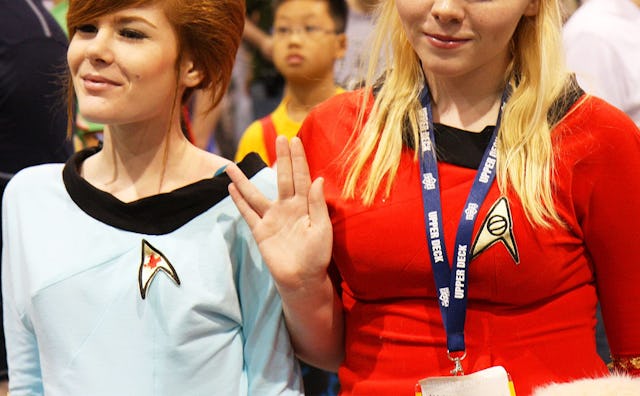On Being Raised A Trekkie

Tribbles, holodecks, transporters, warp speed, tricorders, vulcan mind melds, Ferengi: These are just a few of the terms that were a part of my teenage vernacular growing up in the ’80s and ’90s.
I am a Trekkie, born and raised.
Need proof? Allow me to elaborate.
I speak a little Klingon.
I learned chess on a three-dimensional chess set.
I have worn a Starfleet uniform for Halloween.
I wanted to be Counselor Troi and had recurring nightmares of the Borg.
I had a mad crush on William Riker and wished holodecks were real.
I have seen a Klingon blood drive live in action.
I have been to more than 20 Star Trek conventions. I’ve met William Shatner, Leonard Nimoy and Patrick Stewart (just to name a few) and have the autographs to prove it.
I was named after one of Captain Kirk’s many lovers.
Admitting all of this is easy now, 20 years later, but at the time, this aspect of my life was something I kept guarded. My friends didn’t mock me for my affinity for sci-fi culture, but they didn’t embrace it with me either. My knowledge of Starfleet command certainly didn’t win me any cool points at school, and in fact, I’m quite certain it merely cemented my status at the bottom of the social pyramid.
Yet, it is these memories of sci-fi geekdom that bring about the most nostalgia, quite simply because I experienced every single one of them with my mother.
My mom grew up watching Star Trek. She was a fan from day one. She’s seen every episode of all five original series, including every movie ever made (more than once). She’s read all the books and has even written a few original short stories of her own (years before fan fiction took flight).
My mom is a collector of all things Star Trek. A finished basement adorned with collector plates, autographed photos, phaser replicas, Uhura and Scotty Mr. Potato Heads, Ken and Barbie Starfleet officers and fluffy tribbles feels completely normal, even cozy.
I grew up having two Christmas trees: one traditional and one all black, lit only with white lights and decorated with pewter starships my dad would fondly purchase from Franklin Mint every year for my mom’s birthday.
You gotta hand it to my mother: When she’s in, she’s all in.
Sure, my mom and I did what you might call normal mother-daughter activities as well. We went shopping, we had girl weekends while the boys were off fishing, we enjoyed going out to lunch, and we had the occasional talk about boys, but it is the more eccentric moments we shared that linger most.
How many daughters can recall the time they rocked out to a music video of Geordi La Forge or waited anxiously in line for an autograph from Terry Farrell of Deep Space Nine, all with their mother by their side?
How many daughters can recall sitting with their mother in an auditorium to hear Leonard Nimoy speak about being Jewish or watching a live performance of Patrick Stewart as Prospero in The Tempest?
How many daughters can recall being chosen from the crowd to assist with a live Star Trek auction, all while their mother is cheering them on?
My adolescence, Star Trek and Mom are intrinsically bound in a bizarrely profound way.
Something I once felt the need to hide I now openly embrace, to the amusement of my students and befuddlement of my friends. Something I once thought of as semi-cultish but oddly alluring, I now see as a unique representation of the bonds between mother and daughter.
While the series itself has provided me with several meaningful life lessons—strong female role models to look up to, a celebration of racial diversity, a drive to explore the unknown and pursue my dreams, as well as a deep respect for Shakespeare and epic literature (seriously, Star Trek has got literary allusions in the bag)—what I will always respect most about Star Trek is the pure joy it still brings my mom. There is nothing more inspiring than watching someone else be inspired.
As much as I once tried to deny my Star Trek roots, I’ve now come to appreciate, and even smile at, the words of the Borg, the most eerie of villains.
“Resistance is futile.”
This article was originally published on